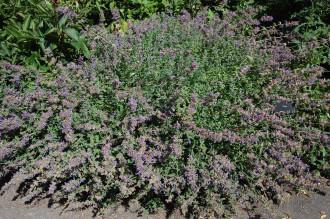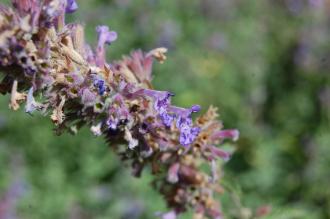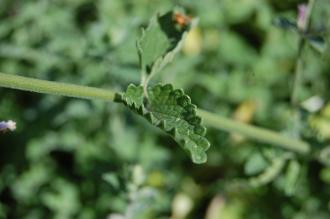
Nepeta racemosa ‘Walker’s Low’ (10/07/2015, Kew Gardens, London)
Position: Full sun to partial shade
Flowering period: Early summer to early autumn
Soil: Moist, Well drained
Eventual Height: 60cm
Eventual Spread: 90cm
Hardiness: 4a, 4b, 5a, 5b, 6a, 6b, 7a, 7b, 8a, 8b, 9a
Family: Lamiaceae
Nepeta racemosa ‘Walker’s Low’ is a deciduous perennial with a clump forming mounding habit. Its dark to silver green leaves are narrowly ovate to lanceolate with entire scalloped margins, up to 4cm long, 2.5cm broad and are aromatic when crushed. Its blue/ mauve flowers appear in racemes on terminal spikes.

Nepeta racemosa ‘Walker’s Low’ Flower (10/07/2015, Kew Gardens, London)
The species Nepeta racemosa, commonly known as Raceme Catnip or Dwarf Catmint, is native to south east Europe and the south Caucasus region. Nepeta racemosa ‘Walker’s Low’ is synonymous with Nepeta x faassenii ‘Walker’s Low’.
The etymological root of the binomial name Nepeta is possibly derived from the common name Ivy of Nepete, where Nepete was the Etruscan town, which notably grew the plant. Racemosa is derived from the Latin meaning ‘flowers in racemes’.
The landscape architect may find Nepeta racemosa ‘Walker’s Low’ useful as an effective low growing ground cover plant with a long flowering period. This plant is drought tolerant once established. It should be noted that this plant is extremely attractive to cats.

Nepeta racemosa ‘Walker’s Low’ Leaf (10/07/2015, Kew Gardens, London)
Ecologically, Nepeta racemosa ‘Walker’s Low’ flowers are attractive to pollinating insects including bees and butterflies. Its leaves are attractive to the larvae of some Lepidoptera species.
The Royal Horticultural Society has given Nepeta racemosa ‘Walker’s Low’ their prestigious Award of Garden Merit in 2012.
Nepeta racemosa ‘Walker’s Low’ prefers moist, fertile, well-drained soils. It tolerates most pH of soil.
Nepeta racemosa ‘Walker’s Low’ requires little maintenance. It may be trimmed back after flowering to encourage a second flowering and maintain a tidy habit. Large clumps may be lifted and divided in spring.

Landscape Architecture

